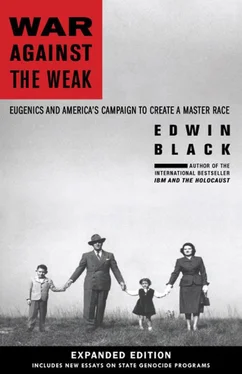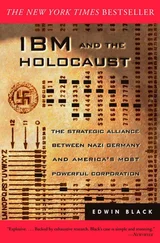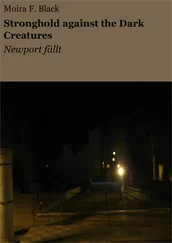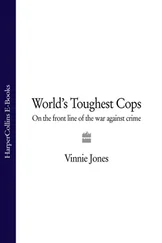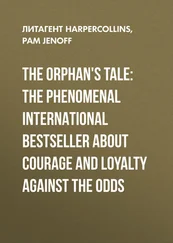Edwin Black - War Against the Weak
Здесь есть возможность читать онлайн «Edwin Black - War Against the Weak» весь текст электронной книги совершенно бесплатно (целиком полную версию без сокращений). В некоторых случаях можно слушать аудио, скачать через торрент в формате fb2 и присутствует краткое содержание. Город: Washington, DC, Год выпуска: 2012, ISBN: 2012, Издательство: Dialog Press, Жанр: История, на английском языке. Описание произведения, (предисловие) а так же отзывы посетителей доступны на портале библиотеки ЛибКат.
- Название:War Against the Weak
- Автор:
- Издательство:Dialog Press
- Жанр:
- Год:2012
- Город:Washington, DC
- ISBN:1-56858-258-7
- Рейтинг книги:3 / 5. Голосов: 2
-
Избранное:Добавить в избранное
- Отзывы:
-
Ваша оценка:
- 60
- 1
- 2
- 3
- 4
- 5
War Against the Weak: краткое содержание, описание и аннотация
Предлагаем к чтению аннотацию, описание, краткое содержание или предисловие (зависит от того, что написал сам автор книги «War Against the Weak»). Если вы не нашли необходимую информацию о книге — напишите в комментариях, мы постараемся отыскать её.
War Against the Weak — читать онлайн бесплатно полную книгу (весь текст) целиком
Ниже представлен текст книги, разбитый по страницам. Система сохранения места последней прочитанной страницы, позволяет с удобством читать онлайн бесплатно книгу «War Against the Weak», без необходимости каждый раз заново искать на чём Вы остановились. Поставьте закладку, и сможете в любой момент перейти на страницу, на которой закончили чтение.
Интервал:
Закладка:
CHAPTER 2
Evolutions
Mankind’s quest for perfection has always turned dark. Man has always existed in perpetual chaos. Continuously catapulted from misery to exhilaration and back, humanity has repeatedly struggled to overcome vulnerability and improve upon its sense of strength. The instinct is to “play God” or at least mediate His providence. Too often, this impulse is not just to improve, but to repress, and even destroy those deemed inferior.
Eventually, the Judeo-Christian world codified the principle that all human life should be valued. A measure of our turbulent civilization and even of our humanity has always been how well people have adhered to that precept. Indeed, as societies became more enlightened, they extended respect for life to an ever-widening circle of people, including the less fortunate and the less strong.
Racism, group hatred, xenophobia and enmity toward one’s neighbors have existed in almost every culture throughout history. But it took millennia for these deeply personal, almost tribal hostilities to migrate into the safe harbor of scientific thought, thus rationalizing destructive actions against the despised or unwanted.
Science offers the most potent weapons in man’s determination to resist the call of moral restraint. To forge the new science of human oppression-a race science-several completely disconnected threads of history twined. Indeed, it took centuries of development for three disciplines-socioeconomics, philosophy and biology-to come together into a resilient and fast-moving pseudoscience that would change the world forever.
Perhaps the story truly begins with the simple concept of charity. Charity is older than the Bible. 1Organized refuges for the poor and helpless date to the Roman era and earlier. 2The concept of extending a helping hand was established in the earliest Judeo-Christian doctrine. “There will always be poor people in the land, therefore, I command you to be open-handed toward your brothers and toward the poor and needy in your land,” declared Deuteronomy. 3Jesus Christ based his ministry on helping the helpless-the lame, the blind, lepers, the mentally deranged, and social outcasts such as thieves and prostitutes. He proclaimed, “The meek… shall inherit the earth.” 4
After the Roman Empire adopted Christianity, the Canones Arabici Nicaeni of 325 A.D. mandated the expansion of hospitals and other monastic institutions for the sick and needy. 5During medieval times, the church was chiefly responsible for “houses of pity.” 6In England, such charitable institutions for the poor were abundantly required.
The Black Death killed millions across Europe between 1348 and 1350. Labor shortages motivated bands of itinerant workers and beggars to wander from town to town in search of the highest paying pittance. As they wandered, many resorted to petty thievery, highway robbery, and worse. With their impoverished existence came the associated afflictions of illiteracy, poor health, rampant disease and physical disability. 7
During the early and mid-1500s, economic upheavals took their toll on all but the richest of the nobility. Silver from the New World and official coinage debasements caused prices to rise, increasing the suffering of the poor. Tribes of vagrants migrated from the countryside to villages. Later, in response to the booming wool market, England’s landowners switched from estate farming to vast sheep breeding enterprises. Consequently, great numbers of farm workers were evicted from their peasant domiciles, bloating the hordes of the unemployed and destitute. This teeming hardship only increased the church’s role in tending to a multitude of the wretched and poor. 8
Everything changed in the 1530s when Pope Clement VII refused to annul Henry VIII’s marriage to Catherine of Aragon. Furious, King Henry seized church property and monasteries in England, and charitable institutions slowly became a governmental responsibility. 9Tending to the poor was expensive but the alternative was food riots. 10
By the early sixteenth century, the first poor laws were enacted in England. Such measures categorized the poor into two groups. The deserving poor were the very young and the very old, the infirm and families who fell on financial difficulties due to a change in circumstances. The undeserving poor were those who had turned to crime-such as highwaymen, pick-pockets, and professional beggars-and also included paupers who roamed the country looking for a day’s work. The undeserving poor were considered an affliction upon society, and the law laid out harsh punishment. Poverty, or more precisely, vagrancy, was criminalized. Indeed, the concept of criminal vagrancy for those with “no visible means of support” has persisted ever since. 11
Despite all attempts to contain welfare spending, England’s enormous expenditures only escalated. In 1572, compulsory poor law taxes were assessed to each community to pay for poor houses and other institutions that cared for the deranged, diseased and decrepit among them. These taxes created a burden that many resented. 12Now it was the poor and helpless against the rest of society.
Indeed, a distinct pauper class had emerged. These people were perceived by the establishment as both an arrogant lot who assumed an inherited “right to relief,” and as seething candidates for riot and revolution. Overcrowded slums and dismal poorhouses caused England to reform its poor laws and poverty policies several times during the subsequent three hundred years. The urbanization of poverty was massively accelerated by the Industrial Revolution, which established grim, sunless sweatshops and factories that in turn demanded-and exploited-cheap labor. Appalling conditions became the norm, inspiring Charles Dickens to rouse the public in novels such as Oliver Twist. Despite progress, by the mid-1800s the state was still spending £1,400 a year (equivalent to about $125,000 in modern money) per 10,000 paupers. The ruling classes increasingly rebelled against “taxing the industrious to support the indolent.” 13
Soot-smeared and highly reproductive, England’s paupers were looked down upon as a human scourge. The establishment’s derogatory language began to define these subclasses as subhumans. For example, a popular 1869 book, The Seven Curses of London, deprecated “those male and female pests of every civilized community whose natural complexion is dirt, whose brow would sweat at the bare idea of earning their bread, and whose stock-in-trade is rags and impudence.” 14
England’s complex of state-sponsored custodial institutions stretched across a distant horizon. Over time, the proliferation of poor houses, lunacy asylums, orphanages, health clinics, epilepsy colonies, rescue shelters, homes for the feebleminded and prisons inevitably turned basic Christian charity into what began to be viewed as a social plague.
While Britain’s perceived social plague intensified, a new social philosophy began evolving in Europe. In 1798, English economist Thomas Malthus published a watershed theory on the nature of poverty and the controlling socioeconomic systems at play. Malthus reasoned that a finite food supply would naturally inhibit a geometrically expanding human race. He called for population control by moral restraint. He even argued that in many instances charitable assistance promoted generation-to-generation poverty and simply made no sense in the natural scheme of human progress. Many who rallied behind Malthus’s ideas ignored his complaints about an unjust social and economic structure, and instead focused on his rejection of the value of helping the poor. 15
In the 1850s, agnostic English philosopher Herbert Spencer published Social Statics, asserting that man and society, in truth, followed the laws of cold science, not the will of a caring, almighty God. Spencer popularized a powerful new term: “survival of the fittest.” He declared that man and society were evolving according to their inherited nature. Through evolution, the “fittest” would naturally continue to perfect society. And the “unfit” would naturally become more impoverished, less educated and ultimately die off, as well they should. Indeed, Spencer saw the misery and starvation of the pauper classes as an inevitable decree of a “far-seeing benevolence,” that is, the laws of nature. He unambiguously insisted, “The whole effort of nature is to get rid of such, and to make room for better…. If they are not sufficiently complete to live, they die, and it is best they should die.” Spencer left no room for doubt, declaring, “all imperfection must disappear.” As such, he completely denounced charity and instead extolled the purifying elimination of the “unfit.” The unfit, he argued, were predestined by their nature to an existence of downwardly spiraling degradation. 16
Читать дальшеИнтервал:
Закладка:
Похожие книги на «War Against the Weak»
Представляем Вашему вниманию похожие книги на «War Against the Weak» списком для выбора. Мы отобрали схожую по названию и смыслу литературу в надежде предоставить читателям больше вариантов отыскать новые, интересные, ещё непрочитанные произведения.
Обсуждение, отзывы о книге «War Against the Weak» и просто собственные мнения читателей. Оставьте ваши комментарии, напишите, что Вы думаете о произведении, его смысле или главных героях. Укажите что конкретно понравилось, а что нет, и почему Вы так считаете.
